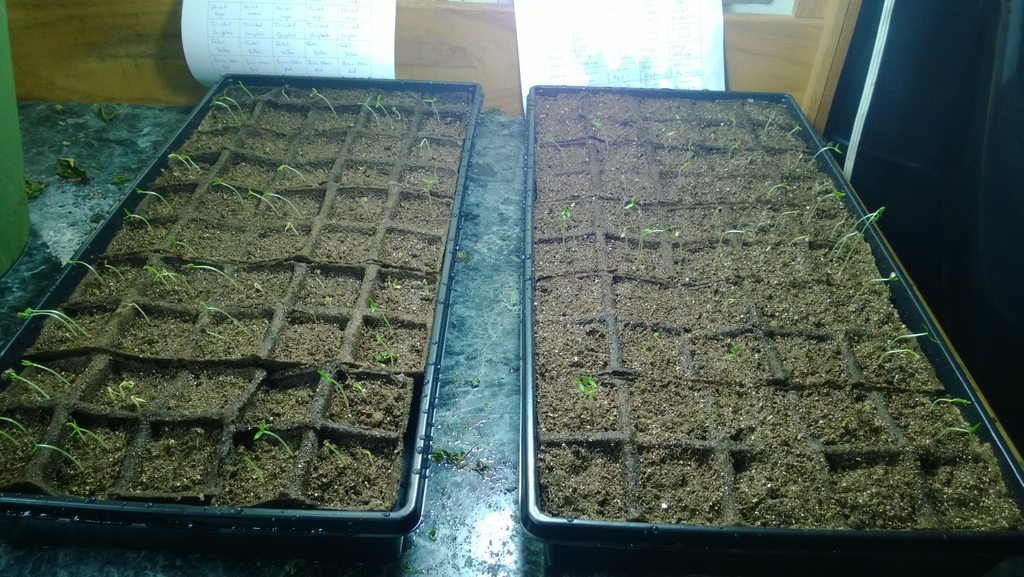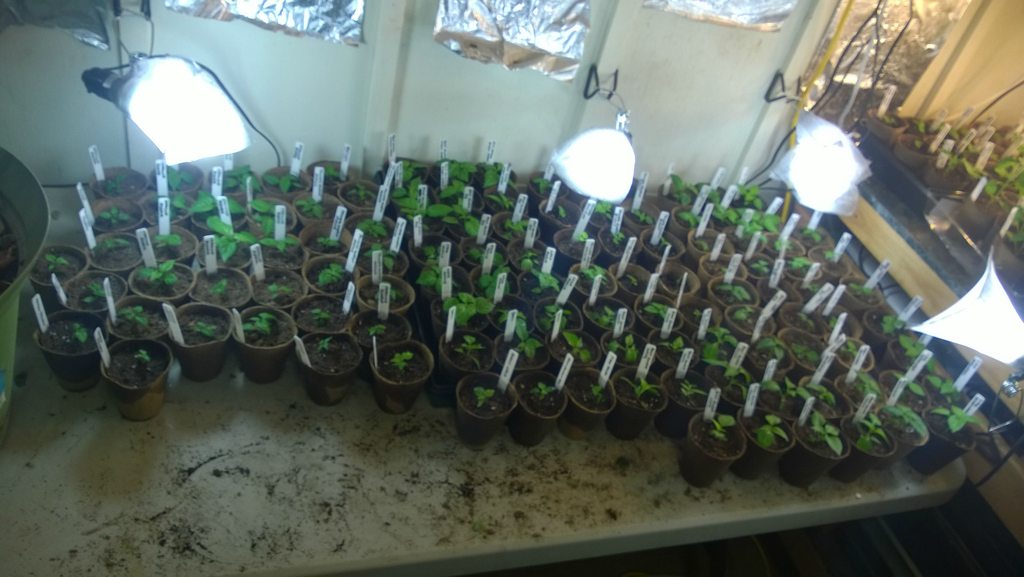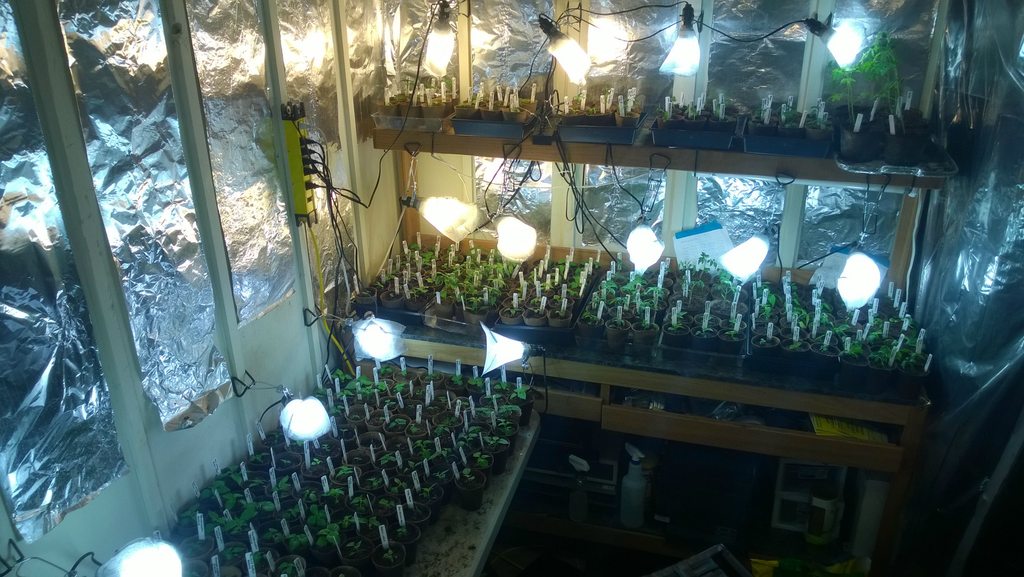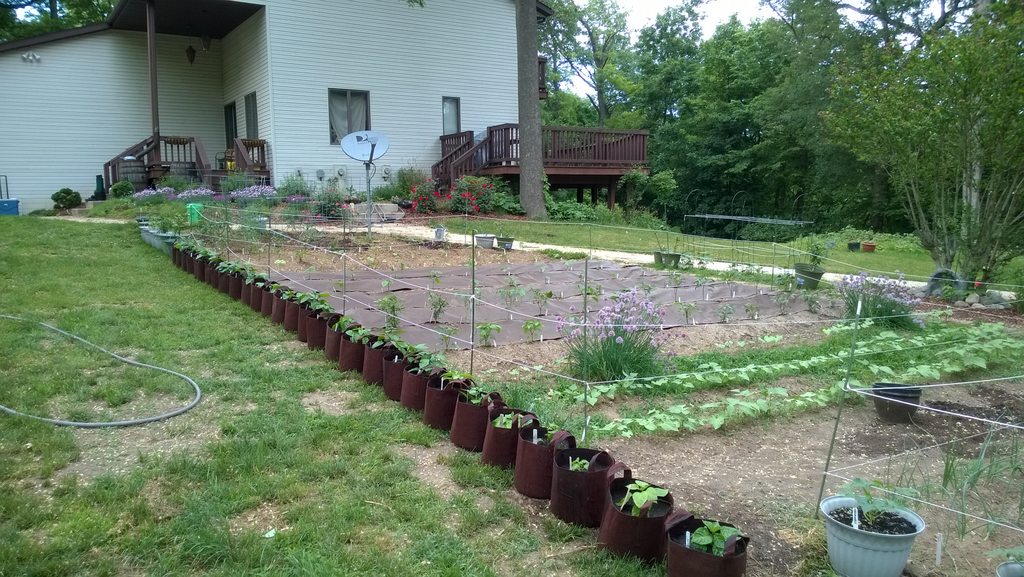Figure I'll keep track 2014 on here. At least then all my data will be in one place instead of scattered around on slips of paper.
First; PSA.
I'll *never* use the Jiffy starting pods / soil again.
I lost 95% of the plants in these two trays:

The roots wouldn't form. They couldn't get any nutrients out of the soil, whatsoever, and tried to suck what they could from the layers of paper.
Burpee trays with compressed peat were planted 3 weeks later and within 3 weeks were quadruple in size.
Finished transplanting all sprouts on Saturday (4-5-2014).


I might lose a couple transplants but here's the current count (all in 3" paper cups)
7 pod Barrackpore - qty 6
7 pod Brain Strain, Yellow - qty 5
7 pod Brain Strain, Red - qty 11
7 pod Chaguanas - qty 7
7-pod Jonah - qty 4
7-pod Long - qty 11
7-pod Original Red - qty 7
7-pod Primo - Qty 3
Bhut Jolokia (brown) - Qty 2
Bhut Jolokia (indian carbon) - qty 6
Bhut Jolokia (red) - qty 9
Bhut Jolokia (yellow) - qty 7
Bhut Jolokia (white) - qty 6
Brown Moruga - qty 6
Carolina reaper - qty 23
Cayenne (Sweet) - qty 3
Cayenne (large) - qty 6
Chili de Abrol - qty 10
True Cumari - qty 1
Datil - qty 3
Dedo De Moca - qty 3
Dorset Naga - qty 3
Fatali, Yellow - qty 4
Giant mexican Rocoto - qty 4
Goats weed - qty 3
Habanero (big sun) - qty 8
Habanero (chocolate) - all died / no sprouts
Habanero (orange) - qty 4
Jalapeno (black) - qty 8
Jalapeno (early) - qty 14
Jalapeno (giant) - qty 15
Mako Akokosrade - qty 3
Naga Morich (orig) - qty 6
Naga Morich (monster naga) - qty 3
Naga morich (bombay morich) - qty 6
Pimenta de Neyde - qty 3
Tobago (seasoning) - all died
Tobago Scotch Bonnet (red) - qty 3
Tobago Scotch Bonnet (yellow) - qty 5
Trinidad Scorpion (butch T) - qty 8
Trinidad Scorpion (Cardi) - qty 4
Trinidad scorpion (douglah) - qty 3
Trinidad scorpion Moruga - qty 7
Trinidad scorpion (orig) - qty 3
Trinidad scorpion (PI 281317) - qty 3
Trinidad Scorpion (smooth) - qty 1
Trinidad Scorpion (yellow) - qty 4
PI 281429 - qty 1
surviving overwinters in large pots:
7-Pod (orig) - qty 1
Bhut Jolokia (red) - qty 2
Bhut Jolokia (giant) - qty 1
Yellow Bhut jolokia - qty 2
Carolina Reaper - qty 4
Cayenne - qty 1
habanero (golden) - qty 3
habanero (tazmanian) - qty 3
Naga morich - qty 1
naga Viper - qty 2
Trinidad Scorpion - qty 1
Butch-T Trinidad - qty 2
Trinidad scorpion moruga - qty 3
Yatsufusa - qty 1
Scotch Bonnet (red) - qty 1 (sole 2012 survivor)
Total 3" pot transplants: 264
Total overwinters surviving: 28
First; PSA.
I'll *never* use the Jiffy starting pods / soil again.
I lost 95% of the plants in these two trays:

The roots wouldn't form. They couldn't get any nutrients out of the soil, whatsoever, and tried to suck what they could from the layers of paper.
Burpee trays with compressed peat were planted 3 weeks later and within 3 weeks were quadruple in size.
Finished transplanting all sprouts on Saturday (4-5-2014).


I might lose a couple transplants but here's the current count (all in 3" paper cups)
7 pod Barrackpore - qty 6
7 pod Brain Strain, Yellow - qty 5
7 pod Brain Strain, Red - qty 11
7 pod Chaguanas - qty 7
7-pod Jonah - qty 4
7-pod Long - qty 11
7-pod Original Red - qty 7
7-pod Primo - Qty 3
Bhut Jolokia (brown) - Qty 2
Bhut Jolokia (indian carbon) - qty 6
Bhut Jolokia (red) - qty 9
Bhut Jolokia (yellow) - qty 7
Bhut Jolokia (white) - qty 6
Brown Moruga - qty 6
Carolina reaper - qty 23
Cayenne (Sweet) - qty 3
Cayenne (large) - qty 6
Chili de Abrol - qty 10
True Cumari - qty 1
Datil - qty 3
Dedo De Moca - qty 3
Dorset Naga - qty 3
Fatali, Yellow - qty 4
Giant mexican Rocoto - qty 4
Goats weed - qty 3
Habanero (big sun) - qty 8
Habanero (chocolate) - all died / no sprouts
Habanero (orange) - qty 4
Jalapeno (black) - qty 8
Jalapeno (early) - qty 14
Jalapeno (giant) - qty 15
Mako Akokosrade - qty 3
Naga Morich (orig) - qty 6
Naga Morich (monster naga) - qty 3
Naga morich (bombay morich) - qty 6
Pimenta de Neyde - qty 3
Tobago (seasoning) - all died
Tobago Scotch Bonnet (red) - qty 3
Tobago Scotch Bonnet (yellow) - qty 5
Trinidad Scorpion (butch T) - qty 8
Trinidad Scorpion (Cardi) - qty 4
Trinidad scorpion (douglah) - qty 3
Trinidad scorpion Moruga - qty 7
Trinidad scorpion (orig) - qty 3
Trinidad scorpion (PI 281317) - qty 3
Trinidad Scorpion (smooth) - qty 1
Trinidad Scorpion (yellow) - qty 4
PI 281429 - qty 1
surviving overwinters in large pots:
7-Pod (orig) - qty 1
Bhut Jolokia (red) - qty 2
Bhut Jolokia (giant) - qty 1
Yellow Bhut jolokia - qty 2
Carolina Reaper - qty 4
Cayenne - qty 1
habanero (golden) - qty 3
habanero (tazmanian) - qty 3
Naga morich - qty 1
naga Viper - qty 2
Trinidad Scorpion - qty 1
Butch-T Trinidad - qty 2
Trinidad scorpion moruga - qty 3
Yatsufusa - qty 1
Scotch Bonnet (red) - qty 1 (sole 2012 survivor)
Total 3" pot transplants: 264
Total overwinters surviving: 28


















